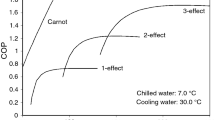Abstract
Solar energy is widely used as one of the most important renewable energy. In addition to the growing applications of solar PV and solar water heater, solar cooling is also considered very valuable and the related researches are developing fast because of the synchronism between solar irradiance and building cooling load. Current studies mainly focus on the high temperature solar collector technique and heat-driven cooling technique, while little concern has been paid to the transport process of cooling power. In this paper, the high temperature radiant cooling is studied as an alternative way for transporting cooling power, and the performance of the combination of radiant ceiling and solar cooling is also studied. From simulation and theoretical analysis results, high temperature radiant cooling terminal shows better cooling power transportation ability against conventional air-conditioning terminal, and its thermal comfort is improved. Experiment results indicate that radiant cooling can enhance the chiller’s COP (Coefficient of Performance) by 17% and cooling power regeneration by 50%. According to analysis in this paper, high temperature radiant cooling is proved to be suitable for solar cooling system, and out work can serve as a reference for later system design and promotion.
Similar content being viewed by others
References
Seyboth K, Beurskens L, Langniss O, et al. Recognising the potential for renewable energy heating and cooling. Energy Policy, 2008 36(7): 2460–2463
Alghoul M A, Sulaiman M Y, Azmi B Z, et al. Advances on multi-purpose solar adsorption systems for domestic refrigeration and water heating. Appl Therm Eng, 2007 27(5–6): 813–822
Afonso C F A. Recent advances in building air conditioning systems. Appl Therm Eng, 2006 26(16): 1961–1971
Balaras C A, Grossman G, Henning H M, et al. Solar air conditioning in Europe-an overview. Renew Sust Energ Rev, 2007 11(2): 299–314
Henning H M. Solar assisted air conditioning of buildings — an overview. Appl Therm Eng, 2007 27(10): 1734–1749
Assilzadeh F, Kalogirou S A, Ali Y, et al. Simulation and optimization of a LiBr solar absorption cooling system with evacuated tube collectors. Renew Energ, 2005 30(8): 1143–1159
Balghouthi M, Chahbani M H, Guizani A. Feasibility of solar absorption air conditioning in Tunisia. Build Environ, 2008 43(9): 1459–1470
Casals X G. Solar absorption cooling in Spain: Perspectives and outcomes from the simulation of recent installations. Renew Energ, 2006 31(9): 1371–1389
Juanico L. A new design of roof-integrated water solar collector for domestic heating and cooling. Sol Energy, 2008 82(6):481–492
Hassan M A, Beliveau Y. Design construction and performance prediction of integrated solar roof collectors using finite element analysis. Construct Build Mater, 2007 21(5): 1069–1078
Syed A, Izquierdo M, Rodríguez P, et al. A novel experimental investigation of a solar cooling system in Madrid. Int J Refrig, 2005 28(6): 859–871
Pongtornkulpanich A, Thepa S, Amornkitbamrung M, et al. Experience with fully operational solar-driven 10-ton LiBr/H2O single-effect absorption cooling system in Thailand. Renew Energ, 2008 33(5): 943–949
Hidalgo M C R, Aumente P R, Millan M, et al. Energy and carbon emission savings in Spanish housing air-conditioning using solar driven absorption system. Appl Therm Eng, 2008 28(14–15): 1734–1744
Li Z F, Sumathy K. Experimental studies on a solar powered air conditioning system with partitioned hot water storage tank. Sol Energy, 2001 71(5): 285–297
Liu X H, Jiang Y. Independent temperature and humidity Controlling air-conditioning system. Beijing: China Architecture & Building Press, 2006
Wang D C, Xia Z Z, Wu J Y, et al. Study of a novel silica gel-water adsorption chiller. Part I. Design and performance prediction. Int J Refrig, 2005 28(7): 1073–1083
Wang D C, Wu J Y, Xia Z Z, et al. Study of a novel silica gel-water adsorption chiller. Part II. Experimental study. Int J Refrig, 2005 28(7): 1084–1091
ASHRAE. HVAC System and Equipment Handbook. Atlanta: ASHRAE, 2000
Author information
Authors and Affiliations
Corresponding author
Additional information
Supported by the National Natural Science Foundation of China (Grant No. 50876064)
About this article
Cite this article
Song, Z., Wang, R. & Zhai, X. Solar-driven high temperature radiant cooling. Chin. Sci. Bull. 54, 978–985 (2009). https://doi.org/10.1007/s11434-009-0069-7
Received:
Accepted:
Published:
Issue Date:
DOI: https://doi.org/10.1007/s11434-009-0069-7




